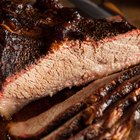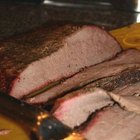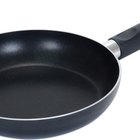
This tough cut of beef requires long, slow cooking to break down the connective fibers in the meat and become tender. The upside of brisket is the flavor -- it's worth the wait. Most of the time, brisket of beef is braised in the oven or cooked in a slow cooker. While steaming is not usually the method of choice, it does result in a fork-tender brisket of beef. Choose the flatter end cut of brisket for steaming.
The Whole Brisket
Step 1
Season the brisket with salt, pepper, thyme, rosemary, sage or your favorite spices. Rub the seasoning into the meat. Refrigerate overnight, tightly wrapped to let the flavors seep in the meat.
Step 2
Take the brisket out of the refrigerator about an hour before you plan to start the steaming. This brings the brisket to room temperature so it cooks more evenly.
Step 3
Brown the meat on all sides in hot oil. You could skip this step but it adds flavor to the brisket.
Step 4
Fill a steamer with enough water so it reaches about 1/2-inch from the bottom of the steaming rack. Add spices and herbs to the water if you wish. You could use the same ones you used to season the brisket. Juice and wine could replace all or part of the water.
Step 5
Put the brisket on the steaming rack. Cover tightly. Bring the liquid to a boil, and then lower the heat so it continues to bubble but not briskly. Steam for two to three hours, depending on the thickness of the brisket. Add more liquid if necessary. Turn the brisket over after an hour of steaming. The brisket should be nearly falling apart and tender when it's done.
Sliced Up
Step 1
Slice the brisket in 1/2-inch slices. Season to taste. The slices expose more of the surface of the brisket to the seasoning so you don't need to use as much seasoning as you would for a whole brisket. While browning adds flavor, browning the slices might cook them through, resulting in a tough dinner experience.
Step 2
Place the slices in the steamer. They should not be touching, so the steam can circulate all around the brisket.
Step 3
Fill the steamer with water to come up to about 1/2-inch below the first rack. Steam for two hours until the slices are tender. If the steamer has a rack with several levels, switch the slices on the bottom rack with those on the top midway through the steaming process.
All Wrapped Up
Step 1
Season the brisket. Refrigerate overnight. Bring the brisket to room temperature. Brown the brisket on all sides. Let it cool until you can handle it, probably no more than 10 minutes.
Step 2
Wrap the brisket tightly in kitchen plastic wrap so it's airtight. The brisket will steam in its own juices. Wrap the roast in aluminum foil over the plastic. Put the brisket bundle in the roasting pan. The foil keeps the plastic from touching the roasting pan.
Step 3
Place in a preheated 300 degree Fahrenheit oven. Steam for two to three hours until the brisket is tender. The aluminum foil is thin enough that it doesn't retain heat, so the plastic wrap doesn't melt as long as it doesn't become any hotter than steam or 212 F.
Related Articles

How to Steam a Brisket of Beef

How to Cook Beef Brisket Slices for a ...

How to Cook Beef Teriyaki Jerky in a ...

How to Steam Wedding Veils

How to Cook a Chuck Short Rib

How to Steam Pork Ribs

How to Convection Roast a Brisket

How to Cook the Neck of a Deer
How to Steam Pork Chops

How to Cook a Partridge

How to Steam Cook Bratwurst

How to Cook Tender Roast Beef

How to Cook a Beef Loin Tri Tip Steak ...

How to Cook Beef Top Round Pot Roast

How to Steam a Dress Shirt Vertically

How to Cook Wild Boar Ribs

How to Cook Ribs Over an Open Pit

How Long Does It Take to Steam a Yam?

How to Use an Offset Smoker to Cook a ...

Steaming a Chiffon Wedding Dress
References
Tips
- Cut the whole brisket to fit in the steamer if necessary.
Warnings
- Steam is very hot. Carefully open the steamer so you don't burn yourself.
Writer Bio
Katie Jensen's first book was published in 2000. Since then she has written additional books as well as screenplays, website content and e-books. Rosehill holds a Master of Business Administration from Arizona State University. Her articles specialize in business and personal finance. Her passion includes cooking, eating and writing about food.
Photo Credits
Comstock/Stockbyte/Getty Images